

|
Line connections |
|
|
|
1 |
Primary side inlet (cold stream, inside tubes) |
|
|
2 |
Primary side outlet (cold stream, inside tubes) |
|
|
3 |
Secondary side inlet (hot stream, outside tubes) |
|
|
4 |
Secondary side outlet (hot stream, outside tubes) |
|
|
5 |
(K*F)-controlling inlet - Heat Transfer Capability |
|
General User Input Values Characteristic Lines Physics Used Displays Example
Component 51 is a multi-purpose component that can be used as economizer, evaporator or super heater.
In addition to characteristic lines CALPM1 and CALPM3 for the heat transfer coefficients, there are two additional characteristic lines for the
for determining the convective heat transfer.
|
Primary |
Secondary |
|
Air |
Air, Flue gas, Crude gas, Oil, Gas, User-defined, Universal fluid |
The following alternatives are set by the flag FMODE:
in design case (GLOBAL = Design)
for off-design (GLOBAL = off-design)
for design (GLOBAL = Design)
for off-design (GLOBAL = Off-design)
for design and off-design (GLOBAL = Design and GLOBAL = Off-design)
Local design
Characteristic lines are used only in the off-design calculations.
Characteristic line CALPM1: relative primary heat transfer coefficient
AL12C/AL12CN = f (M1/M1N)
Characteristic line CALPM3: relative secondary heat transfer coefficient
AL34C/AL34CN = f (M3/M3N)
Characteristic line CRAD: relative heat transfer by radiation
(AL34R/AL34RN) *(T34N/T34)**3 = f(T34/T34N)
Characteristic line CLAM: relative thermal conductivity
ALAM/ALAMN = f(T34/T34N)
For more information on general notes applicable to most common heat exchangers, see Heat Exchanger General Notes
Design:
The values not specified are calculated with the terminal temperature difference or heat transfer area (nominal). Furthermore is calculated (k * A).
If the terminal temperature differences are specified, it is important that depending upon the heat value (M*cp), either the lower or the upper terminal temperature (see Heat Exchanger General ) difference leads to correct results.
When using complex cycle arrangements for heat exchangers, it is often not easy to determine the settings of all terminal temperature differences in a useful manner. Error messages occur frequently because an inoperable heat exchanger may also cause some errors in other heat exchangers. To avoid this (k*A) can be entered instead of terminal temperature differences. This can be done in the design mode by using the mode "local off-design". An input of (k*A) always leads to physically possible results. The desired result can be determined through iterative calculations with different (k*A) values.
Off-Design:
The values that are not given will be determined by a (k*A) entry. Also the terminal temperature differences are calculated.
The (k*A)-value of the off-design calculation results from the (k*A)-value of the design calculation multiplied by a correction factor that is determined by one or more characteristic lines.
The following method of calculation serves as a basis:
1st characteristic line CALPM1 FK1 = AL12C/AL12CN = f (M1/M1N)
2nd characteristic line CALPM3 FK2 = AL34C/AL34CN = f (M3/M3N)
3rd characteristic line CRAD FK3= (AL34R/AL34RN) *(T34N/T34)**3 = f(T34/T34N)
4th characteristic line CLAM FK4 = ALAM / ALAMN = f(T34/T34N)
1/K = 1/AL12C + 1/(AL34C + AL34R) +1/ALAM
1/KN = 1/AL12CN + 1/(AL34CN + AL34RN) +1/ALAMN
KA = KAN * K / KN
Adjustable tolerance limit for the evaporation in an economizer:
Moreover, a threshold TOLXECO has been implemented, up to which an evaporation in the economizer is tolerated. If the steam mass fraction downstream of the economizer is greater than this threshold, a warning message will be output; if it is greater than twice this threshold, an error message will be output.
Note: Nevertheless, the calculation does not distinguish between economizer and evaporation zone but uses a the same k value for both zones.
It is also possible for all components to use the flag FVOL to determine whether the off-design calculation of the pressure drop shall consider only the mass-flow (approximation for incompressible fluids) or mass and volume flow.
Pinch point violations in the case of heat exchangers: see Heat Exchanger General Notes
Up to release 10.0, a pinchpoint violation was only determined subsequently in partial load, i.e. KA was calculated for the respective load case and from this the transferred heat quantity and then it was checked whether this heat quantity can be transferred at all at the correct temperature level. Since in the case of evaporation or condensation the temperature remains constant despite heat input or heat removal, there are cases where heat transfer is not physically possible despite the overall balance being correct. In this case, an error message was issued in Ebsilon.
The calculation has now been changed in such a way that the transferred heat quantity is reduced as far as it is still physically possible, with the minimum pinch point can be set in a default value PINPMIN. This results in a correspondingly reduced KA.
The user is informed of this by a warning message ("KA reduced to avoid pinchpoint violation") and can then adjust the part-load characteristic curve or the part-load exponent for KA accordingly so that the warning no longer occurs. The advantage, however, is that one gets a physically possible result in any case.
Furthermore, at the end of the calculation there is a check if there is a pinch point violation due to curved course of Q(T) (caused by significant changes of cp depending on the temperature). This can be verified by dividing the heat exchanger into individual sections.
This case can occur, for example, when on the hot side the cp at the inlet is significantly smaller than at the outlet (for example, steam that has a cp of about 2 kJ/kgK at high superheat, but more than 5 just above the boiling line). This means that this steam provides more heat at a lower temperature level than at a high one. At appropriately low degrees, this can be a limitation on the amount of heat transfer that is possible.
The QT diagrams take into account the non-linearity (curvature of the curves) in areas without phase change.
The flag FSPEC (deprecated) has been divided into two flags:
Note:
When loading a model that was created with Release 11 (or older), the corresponding values for FTYPHX, FSPECD, are determined from the value of the flag FSPEC, and FSPEC is set to “void” (-999). The model then calculates the same result values. If required, however, the flag FSPEC can still be used as well.
To remove ambiguity, the terms “primary side” and “secondary side” respectively have been replaced by “cold side” and “warm side” in the input screens. The cold side is the flow from Pin 1 to Pin 2 that is heated. The warm side is the flow from Pin 3 to Pin 4 that gives off the heat.
Design in the Case of Concurrent Flow
In the heat exchanger (Components 51) it is possible to carry out a design via the upper and lower terminal temperature difference also in the case of concurrent flow (FFLOW=1).
If both inlet temperatures are specified, the upper terminal temperature difference can only be determined iteratively. Usually this is no problem. If convergence problems occur in more complex models, another design mode will have to be used.
Effectiveness Method
See Heat Exchangers General Information Effectiveness Method
Specification of the surface area for designing heat exchanger (specification value AN)
Usually, heat exchangers are designed in Ebsilon by specifying the terminal temperature differences or temperatures to be achieved. In an iterative process, the transferred amount of heat and the product of heat transfer coefficient and surface area (k*A) characteristic for the heat exchanger are calculated from this. Its nominal value KAN then serves to calculate the temperatures in off-design calculations. It is not necessary to know the individual values k and A here.
In the case of the component High Temperature Heat Exchanger ( Component 51), the off-design behaviour is defined by exponents of heat transfer coefficients AL12 and AL34. As k can be calculated from it, the heat exchanger surface area A is available as well.
This has been used to implement a design calculation via the specification of the surface area. It is, however, essential to correctly specify the nominal values for the heat transfer coefficients AL12CN and AL34CN, which had only an effect on the partial load behaviour before to implementation of AN (area).
The specified surface area is only used for the design calculation to determine KAN from it. In the off-design calculation KAN is then used for the calculation.
Specific heat capacity : CP12 / CP34
The mean specific heat capacity is displayed as a result value on the cold side (CP12) and on the hot side (CP34).
The mean specific heat capacity results from the quotient of the enthalpy difference and the temperature difference.
If no temperature difference is present (e.g. in the two-phase range or when the heat exchanger is shut off), however, it is not possible to calculate this quotient. In this case, the specific heat capacity at the respective temperature is used, provided that it is defined. Otherwise the result value will remain blank.
Performance factor RPFHX
The quotient from the current value for k*A (result value KA) and the k*A expected in the respective load point due to the component physics and characteristic lines respectively (result value KACL) serves to assess the condition of a heat exchanger.
The quotient KA / KACL is displayed as a result value RPFHX.
For more information on how this heat exchangers compares to other heat exchangers, see Heat Exchanger General Notes
|
FTYPHX |
Type of heat exchanger = 0: General heat exchanger |
|
FSPECD |
Calculation method in design-case
= 0: Specification of the effectiveness (ratio of transferred heat to the theoretical maximum at infinite transfer surface) in the specification value EFF |
|
DP12N |
Cold side pressure loss (nominal) |
|
DP34N |
Hot side pressure loss (nominal) |
|
DTN |
Terminal temperature difference or temperature in design mode (nominal, dependent on FSPEC) for FSPECD=1: lower terminal temperature difference (T4 - T1) for FSPECD=2: upper terminal temperature difference (T3 - T2) for FSPECD=3: T4 |
|
EFF |
Effectiveness |
|
AN |
Heat transfer area (nominal) , for FSPECD = 9 |
|
TOL |
Tolerance in the energy balance |
|
T34N |
Average temperature for radiation (nominal) |
|
AL12CN |
Cold side convection heat-transfer coefficient (nominal) |
|
AL34CN |
Hot side convection heat-transfer coefficient (nominal) |
|
AL34RN |
Hot side radiation heat-transfer coefficient (nominal) |
|
ALAMN |
Heat conductance of the material (nominal) |
|
FFLOW |
Switch for direction of flow see Heat Exchanger General Notes =0: Counter Current flow =1: Concurrent flow |
|
FMODE |
Calculation mode =0: GLOBAL =1: Local off-design =2: Special local off-design (see above) =3: (Design) Use of K*A regulated, (off-design) alpha-characteristic line =4: All modes: Use of K*A regulated =-1: Local design |
|
FADAPT |
Flag for adaptation polynomial ADAPT / adaptation function EEADAPT =0: Not used and not evaluated =1: Correction for k*A [KA = KAN * Char Line factor * polynomial] =2: Calculation of k*A [KA = KAN * polynomial] =1000: Not used but ADAPT evaluated as RADAPT (Reduction of the computing time) = -1: Correction for k*A [KA = KAN * Char Line factor * adaptation function] = -2: Calculation of k*A [KA = KAN * adaptation function] = -1000: Not used but EADAPT evaluated as RADAPT (Reduction of the computing time) |
|
EADAPT |
Adaptation function for KA |
|
FFU |
Switch on/off =0: Heat exchanger off (no heat transfer, but calculation of pressure losses) =1: Heat exchanger on (active) |
|
PINPMIN |
Minimum value for the pinch point (KA is reduced automatically if the pinch point would fall below this value) |
|
TOLXECO |
Tolerance for evaporation in economizer. If the steam content X at the economizer outlet is > TOLXECO, a warning message is issued. If it is > 2*TOLXECO, an error message is issued. |
|
FVOL |
Flag for part load pressure drop =0: only depending on mass flow DP/DPN = (M/MN)**2 =1: depending on mass and volume flow DP/DPN = V/VN*(M/MN)**2 =2: constant pressure drop (no load dependency) |
|
FSPEC (deprecated) |
Deprecated specification combi switch = -999: Unused (FSPECD and FIDENT used instead) Old values: =1: General heat-exchanger, user specifies lower terminal temperature difference =2: General heat-exchanger, user specifies upper terminal temperature difference =3: General heat-exchanger, user specifies T4 =11: Economizer, user specifies lower terminal temperature difference =12: Economizer, user specifies upper terminal temperature difference =13: Economizer, user specifies T4 =21: Evaporator, user specifies lower terminal temperature difference =22: Evaporator, user specifies upper terminal temperature difference =23: Evaporator, user specifies T4 =31: Super Heater, user specifies lower terminal temperature difference =32: Super Heater, user specifies upper terminal temperature difference =33: Super Heater, user specifies T4 |
|
KAN |
Heat transfer coefficient * area (nominal) - Design Heat Transfer Capability |
|
M1N |
Cold side mass flow (nominal) |
|
M3N |
Hot side mass flow (nominal) |
|
V1N |
Specific volume at cold side inlet (nominal) |
|
V3N |
Specific volume at hot side inlet (nominal) |
The parameters marked in blue are reference quantities for the off-design mode. The actual off-design values refer to these quantities in the equations used.
Generally, all inputs that are visible are required. But, often default values are provided.
For more information on colour of the input fields and their descriptions see Edit Component\Specification values
For more information on design vs. off-design and nominal values see General\Accept Nominal values
1st Characteristic line FK1 = AL12C/AL12CN = f (M1/M1N)
2nd Characteristic line FK2 = AL34C/AL34CN = f (M3/M3N)
3rd Characteristic line FK3 = (AL34R/AL34RN) *(T34N/T34)**3 = f(T34/T34N)
4th Characteristic line FK4 = ALAM / ALAMN = f(T34/T34N)
1/K = 1/AL12C + 1/(AL34C + 1/AL34R) +1/ALAM
1/KN = 1/AL12CN + 1/(AL34CN + 1/AL34RN) +1/ALAMN
KA = KAN * K/KN
|
Characteristic line1: ALPHA-Characteristic line: AL12C/AL12CN = f (M1/M1N) |
|
X-axis 1 M3/M3N 1st point Y-axis 1 AL12C/AL12CN 1st point |
|
Characteristic line2: ALPHA-Characteristic line: AL34C/AL34CN = f (M3/M3N) |
|
X-axis 1 M3/M3N 1st point |
|
Characteristic line 3: ALPHA-Characteristic line: (AL34R/AL34RN) *(T34N/T34)**3 = f(T34/T34N) |
|
X-axis 1 T34/T34N 1st point |
Remarks for line 3: the characteristic lines are approximated by referring to the third power of the temperature
|
Characteristic line 4: heat transfer-characteristic line : ALAM / ALAMN = f(T34/T34N) |
| X-axis 1 T34/T34N 1st point 2 T34/T34N 2nd point . N T34/T34N last point Y-axis 1 ALAM / ALAMN 1st point 2 ALAM / ALAMN 2nd point . N ALAM / ALAMN last point |
|
Design (Simulation flag: GLOBAL = Design and FMODE = Design) |
||
|
|
if the lower terminal temperature difference is given by FSPEC, then { P4 = P3 - DP34N T4 = T1 + DTN H4 = f(P4,T4) M4 = M3 Q4 = M4 * H4 DQ = (Q3 - Q4) P2 = P1 - DP12N Q2 = Q1 + DQ M2 = M1 H2 = Q2/M2 T2 = f(P2,H2) DTLO = T4 - T1 (for FFLOW = counter current) DTUP = T3 - T2 (for FFLOW = counter current) LMTD = (DTUP - DTLO)/(ln(DTUP) - ln(DTLO)) KAN = DQ/LMTD KAN*LMTD = M2*H2 - M1*H1 KAN*LMTD = M3*H3 - M4*H4 } if the upper terminal temperature difference is given by FSPEC, then { P2 = P1 - DP12N T2 = T3 - DTN M2 = M1 H2 = f(P2,T2) Q2 = M2 * H2 DQ = Q2 - Q1 P4 = P3 - DP34N Q4 = Q3 - DQ M4 = M3 H4 = Q4/M4 T4 = f(H4,P4) DTLO = T4 - T1 (for FFLOW = counter current) DTUP = T3 - T2 (for FFLOW = counter current) LMTD = (DTUP - DTLO)/(ln(DTUP) - ln(DTLO)) KAN = DQ/LMTD KAN*LMTD = M2*H2 - M1*H1 KAN*LMTD = M3*H3 - M4*H4 } if the temperature T4 is specified with FSPEC, then { P4 = P3 - DP34N T4 = DTN H4 = f(P4,T4) M4 = M3 Q4 = M4 * H4 DQ = Q3 - Q4 P2 = P1 - DP12N Q2 = Q1 + DQ M2 = M1 H2 = Q2/M2 T2 = f(P2,H2) DTLO = T4 - T1 (for FFLOW = counter current) DTUP = T3 - T2 (for FFLOW = counter current) LMTD = (DTUP - DTLO)/(ln(DTUP) - ln(DTLO)) KAN = DQ/LMTD KAN*LMTD = M2*H2 - M1*H1 KAN*LMTD = M3*H3 - M4*H4 } |
|
|
Off-design case (Simulation flag: GLOBAL = Off-design case or FMODE = Off-design case) |
||
|
|
TOL = 0.00001
if FVOL = "depending on mass flow", then { F3 = (M3/M3N) ** 2 if FVOL= "depending on mass and volume flow", then { F1 = V1/V1N*(M1/M1N) ** 2 F3 = V3/V3N*(M3/M3N) ** 2 P2 = P1 - DP12N * F1 M2 = M1 if GLOBAL = off-design or (FMODE = 1 or FMODE = 3) then { Fk1 = f(M1/M1N) characteristic line 1 for MODE = design, Fk1=1 Fk2 = f(M3/M3N) characteristic line 2 for MODE = design Fk2=1 Fk3*(T34N/T34)**3 = f(T34/T34N) characteristic line 3 for MODE = design Fk3=1 FK4 = ALAM / ALAMN = f(T34/T34N) characteristic line 4 for MODE = design Fk4=1 1/K = 1/AL12C + 1/(AL34C + 1/AL34R) +1/ALAM 1/KN = 1/AL12CN + 1/(AL34CN + 1/AL34RN) +1/ALAMN KA=KAN * K/KN} if GLOBAL = design and (FMODE = 3 or FMODE = 4) then { KA = H6 (via controlling) } if GLOBAL = off-design and FMODE = 4 then { KA = H6 (via controlling) } P4 = P3 - DP34N * F3 M4 = M3 + M5
Maximum/minimum values for the iterations { H2max = f(P2,T3) Q12max = M1 * (H2max - H1) H4min = f(P4,T1) Q34max = Q3 - M4 * H4min } for FFLOW = counter current { Qmax = min(Q12max,Q34max) } for FFLOW = concurrent { Estimation for iteration start 1 QA = min(Q12max,Q34max) QM = QA*QA/(Q12max+Q34max) Iteration1{ H2 = H1 + QM/ M2 T2 = f(P2,H2) T4 = T2 H4 = f(P4,T4) QK = Q3 -M4 * H4 DQQ_1 = DQQ DQQ = QM - QK regula - falsi method { step width = (QM - QM_1)/(DQQ - DQQ_1) for iteration step 1: step width of the last global step QMU = QM - DQQ * step width QM_1 = QM QM = QMU } DQ = | DQQ/((QM+QK)*.5) |
if DQ < TOL then end iteration 1 else continue the iteration } Qmax = QM } Q12 = 0.5*Qmax Iteration2{ H4 = (Q3 - Q12)/M4 T4 = f(P4,H4) H2 = H1 + Q12/M2 T2 = f(P2,H2) DTLO = T4 - T1 (for FFLOW = counter current) DTUP = T3 - T2 (for FFLOW = counter current) DTLO = T4 T2 (for FFLOW = concurrent) DTUP = T3 T1 (for FFLOW = concurrent) LMTD = (DTUP - DTLO)/(ln(DTUP) - ln(DTLO)) QQ = KA * LMTD DQQ_1 = DQQ DQQ = Q12 - QQ regula - falsi method { step width = (Q12 - Q12_1)/(DQQ - DQQ_1) for iteration step 1: step width of the last global step Q12X = Q12 - DQQ * step width Q12_1 = Q12 Q12 = Q12X } DQ = |DQQ /((Q12+QQ)*.5)| if DQ < TOL, then end iteration2 else continue the iteration } KA*LMTD = M2*H2 - M1*H1 KA*LMTD = M3*H3 - M4*H4 |
|
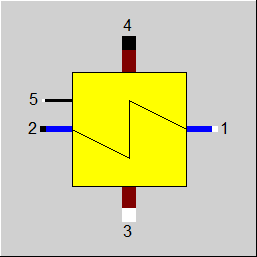 |
Display Option 1 |
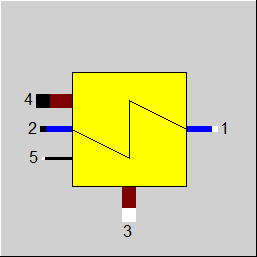 |
Display Option 2 |
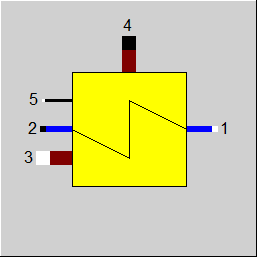 |
Display Option 3 |
 |
Display Option 4 |
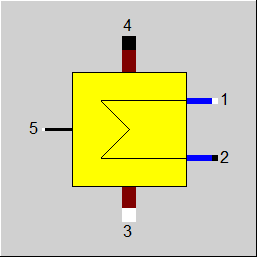 |
Display Option 5 |
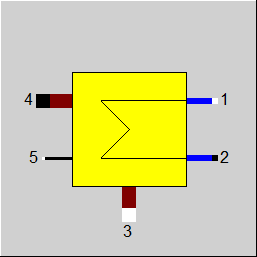 |
Display Option 6 |
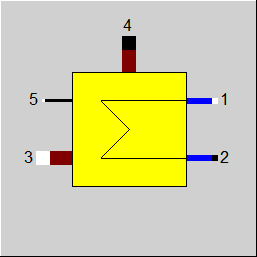 |
Display Option 7 |
 |
Display Option 8 |
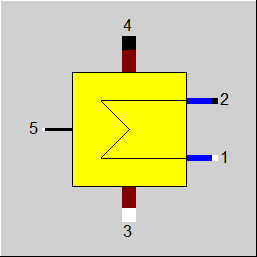 |
Display Option 9 |
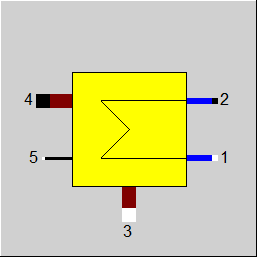 |
Display Option 10 |
 |
Display Option 11 |
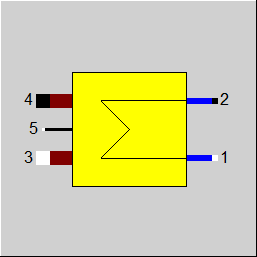 |
Display Option 12 |
Click here >> Component 51 Demo << to load an example.